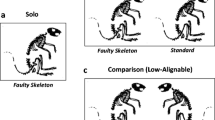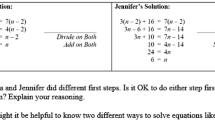Abstract
This study attempts to specify the relational calculi that young students elaborate for solving compare problems, which have been identified as being among the most difficult of the addition problems. Based on an integration of hypotheses and models from research attempting to account for problem-solving activity on these problems, an a priori analysis makes explicit the relational calculi capable of leading to the solution of six compare problems. This analysis provides a foundation for an analysis of protocols, which were collected from 25 first-grade students solving and reformulating compare problems. The results highlight the dynamic character of the structuring and arithmetizing processes in setting up the relationships within a problem. Thus, the numerical calculi employed are interpreted as a function of the structure of the problem and, in turn, the situation described by the problem derives its meaning from a knowledge of the arithmetic operations activated by the numerical calculi.
Résumé
L’étude présentée dans cet article vise à preciser les calculs relationnels elaborés par des jeunes élèves pour résoudre des problèmes de comparaison d’états, lesquels sont indentifiés, par les études effectuées dans ce domaine, parmi les plus difficiles des problèmes additifs. Cette étude procède d’une intégration d’hypothèses et de modèles issus de recherches visant à rendre compte de l’activité de résolution de ces problèmes. Une analyse a priori spécifiant les calculs relationnels pouvant mener à la résolution de six problèmes de comparaison sert d’assise à une analyse de protocoles recueillis auprès de 25 élèves de première année primaire en contexte de résolution et de formulation de problèmes de comparaison d’états. Les résultats mettent en évidence le caractère dynamique des processus de structuration et d’arithmétisation des relations à établir. Ainsi, les calculs numériques mis en oeuvre prennent une signification au regard de la structure du problème et, en retour, la situation décrite par le problème prend une signification au regard des connaissances sur les opérations mobilisées par les calculs numériques.
Similar content being viewed by others
References
Bilsky, L.H., & Judd, T. (1986). Sources of difficulty in the solution of verbal arithmetic problems by mentally retarded and non retarded individuals.American Journal of Mental Deficiency, 90, 395–402.
Brousseau, G. (1986). Fondements et méthode de la didactique des mathématiques.Recherches en Didactique des Mathématiques, 7, 33–115.
Brun, J. (1990). La résolution de problèmes arithmétiques: Bilan et perspectives.Math École, 141, 3–14.
Carpenter, T.P., & Moser, F. (1982). The development of addition and subtraction problem-solving skills. In T.P. Carpenter, J.M. Moser, & T.A. Romberg (Eds.),Addition and subtraction: A cognitive perspective (pp. 9–37), Hillsdale, NJ: Erlbaum.
Carpenter, T.P., Hiebert, J., & Moser, F. (1981). Problem structure and first-grade children’s initial solution process for simple addition and subtraction problems.Journal of Research in Mathematics Education, 12, 27–39.
Conne, F. (1985). Calculs numériques et calculs relationnels dans la résolution de problèmes d’arithmétique.Recherches en Didactique des Mathématiques, 5, 269–332.
Deblois, L. (1997). Quand additionner et soustraire implique comparer.Éducation et Francophonie, 25, 102–120. (http://www.acelf.ca/revue)
De Corte, E., & Verschaffel, L. (1987). The effect of semantic structure on first graders’ strategies for solving addition and subtraction word problems.Journal of Research in Mathematics Education, 18, 363–381.
Ehrlich, S. (1990).Sémantique et mathématique: Apprendre/Enseigner l’arithmétique simple. Paris: Nathan.
Fayol, M. (1990).L’enfant et le nombre: Du comptage à la résolution de problèmes. Paris: Delachaux et Niestlé
Fischer, J.P. (1993). La résolution des problèmes arithmétiques verbaux: Propositions pour un enseignement pro-actif.Annales de Didactique et de Sciences Cognitives, 5, 177–210.
Fuson, K. (1988).Children’s counting and concepts of number. New York: Springer-Verlag.
Fuson, K. (1991). Relations entre comptage et cardinalité chez les enfants de 2 à 8 ans. In J. Bideaud, C. Meljac, & J.P. Fischer (Eds.),Les chemins du nombre (pp. 159–179). Lille: Presses Universitaires de Lille.
Giroux, J., & Lemoyne, G. (1998). Coordination of knowledge of numeration and arithmetic operations in first grade students.Educational Studies in Mathematics, 35, 283–301.
Julo, J. (1995).Représentation des problèmes et réussite en mathématiques. Rennes: Presses Universitaires de Rennes.
Lewis, A.B. (1989). Training students to represent arithmetic word problems.Journal of Educational Psychology, 81, 521–531.
Lewis, A.B., & Mayer, R. (1987).Students’ miscomprehension of relational statements in arithmetic word problem.
Kamii, C. (1990).Les jeunes enfants réinventent l’arithmétique. Berne: Peter Lang.
Nesher, P. (1982). Levels of descriptions in the analysis of addition and subtraction word problems. In T.P. Carpenter J.M. Moser, & T.A. Romberg (Eds.),Addition and subtraction: A cognitive perspective (pp. 25–38). Hillsdale, NJ: Erlbaum.
Piaget, J., & Szeminska, A. (1941).La genèse du nombre chez l’enfant. Neuchâtel: Delachâux et Niestlé.
Ryley, M.S., Greeno, J.G., & Heller, J.I. (1983). Development of children’s problem-solving ability in arithmetic. In H.P. Ginsburg (Eds.),The development of mathematical thinking (pp. 153–196). New York: Academic Press.
Ryley, M.S., & Greeno, J. (1988). Developmental analysis of understanding language about quantities and of solving problems.Cognition and Instruction, 5, 49–101.
Steffe, L. (1991). Stades d’apprentissage cans la construction de la suite des nombres. In J. Bideaud, C. Meljac, & J.P. Fischer (Eds.),Les chemins du nombre (pp. 113–132). Lille: Presses Universitaires de Lille.
Studer, C. (1994). Une catégorie de problèmes additifs: Les problèmes de comparaison de 1P à 4P.Mémoire de licence inédit. Genève: Université de Genève.
Vergnaud, G. (1982). A classification of cognitive tasks and operations of thought involved in addition and subtraction problems. In T.P. Carpenter, J.M. Moser, & T.A. Romberg (Eds.),Addition and subtraction: A cognitive perspective (pp. 39–59). Hillsdale, NJ: Erlbaum.
Vergnaud, G. (1985).L’enfant, la mathématique et la réalité, Berne: Peter Lang.
Vergnaud, G. (1991). L’appropriation du concept du nombre: Un processus de longue haleine. In J. Bideaud, C. Meljac, & J.P. Fischer (Eds.),Les chemins du nombre (pp. 271–282). Lille: Presses Universitaires de Lille.
Vergnaud, G., & Durand, C. (1976). Structures additives et complexité psychogénétique.Revue Française de Pédagogie, 36, 28–43.
Verschaffel, L. (1994). Using retelling data to study elementary school children’s representations and solutions of compare problems.Journal of Research in Mathematics Education, 25, 141–165.
Author information
Authors and Affiliations
Corresponding author
Additional information
This work has been financially supported by grants to Jacinthe Giroux from the Social Sciences and Humanties Research Council of Canada (SSHRC) and from the Fonds pour la Formation de Chercheurs et l’Aide à la Recherche (FCAR), Government of Québec.
Rights and permissions
About this article
Cite this article
Giroux, J., Ste-Marie, A. The solution of compare problems among first-grade students. Eur J Psychol Educ 16, 141–161 (2001). https://doi.org/10.1007/BF03173022
Received:
Revised:
Issue Date:
DOI: https://doi.org/10.1007/BF03173022




